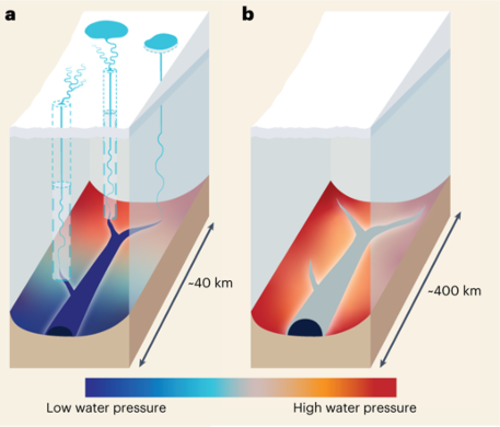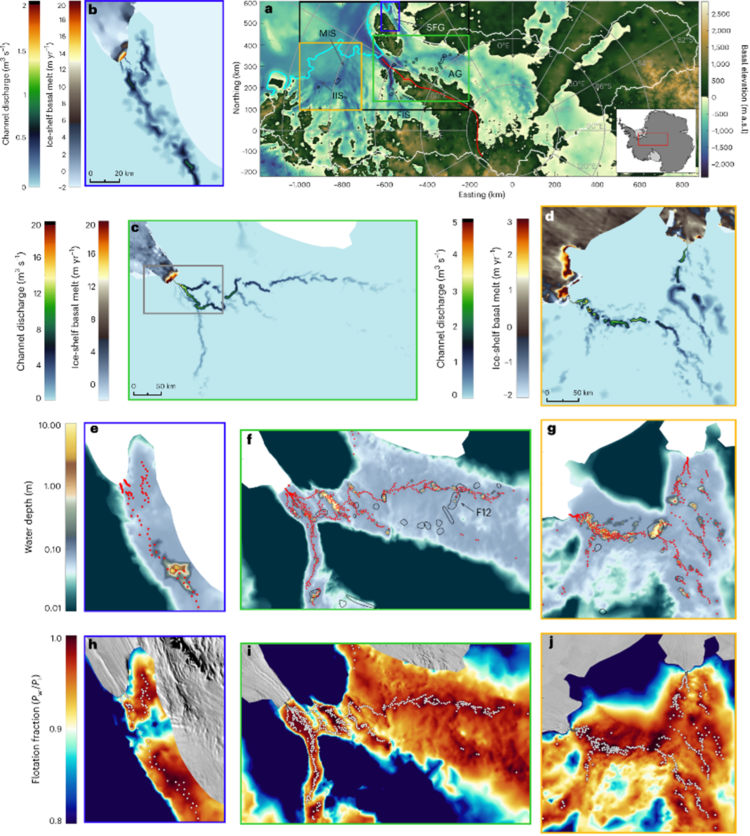Contact
![]()
 Christine Dow, Department of Geography and Environmental Management
Christine Dow, Department of Geography and Environmental Management
Introduction
The stability of ice sheets and their impact on sea levels are modulated by high-pressure subglacial (basal) water that lubricates the base of the ice and facilitates rapid flow into the ocean. In contrast to Greenland and Alpine glaciers, the impact of basal hydrology on Antarctic ice-sheet systems is poorly characterized, limiting understanding of ice-sheet flow and its sensitivity to climate forcing.
While Greenlandic glaciers have seasonally varying hydrology with surface-water inputs during the summer, Antarctic systems are driven entirely by in situ basal water production and seasonally stable configurations (Figure 1). Although Antarctic basal hydrology has been estimated through simple hydraulic potential modelling, this has not allowed for examination of (1) the presence or size of subglacial channels, (2) how far upstream such channels can persist, (3) the volume and discharge of subglacial water or (4) temporal persistence of the subglacial drainage network. This study characterizes the role of subglacial water in modulating Antarctic ice flow and basal melting in ice-shelf ocean cavities, which is important for predicting future sea-level rise.

Figure 1. Schematic of subglacial hydrology drainage characteristics for Greenland and Antarctica
a, In Greenland, seasonal surface-water accesses the bed and allows channel development with enough efficiency to lower the water pressure over a distance of tens of kilometres. B, In Antarctica, there is no surface-water input, but channels can develop over hundreds of kilometres due to near steady-state inputs. These channels do not lower the surrounding water pressure substantially.
Methodology
The study used the finite-element Glacier Drainage System (GlaDS) model, which allows coincident development of inefficient and channelized drainage networks to assess the basal hydrology of four major ice catchments that feed ice to the Filchner–Ronne Ice Shelf (FRIS) in the Weddell Sea Sector of Antarctica: Institute Ice Stream (IIS); Mӧller Ice Stream (MIS); Support Force Glacier (SFG); and Foundation Ice Stream/Academy Glacier (FIS–AG) (Figure 2a). GlaDS was run over the four catchments with a variety of sensitivity tests, including channel and distributed system conductivity, which permitted the assessment of the extent of channelization and the role that channels play in reducing surrounding water pressure and slowing ice flow.

Figure 2: Modelled subglacial hydrology.
a, Basal topography of the study region with the model domain outlined in white and the grounding line in cyan. The divide between West and East Antarctic Ice Sheets is plotted in red, and the locations of ICESat lakes are outlined in black.b–d, Ice-shelf melt rates from Cryosat-2 altimetry measurements and modelled channel discharge for (b) SFG, (c) FIS-AG and (d) IIS and MIS. e–g, Distributed system water depth with channels plotted in red and the locations of ICESat lakes outlined in black for (e) SFG, (f) FIS-AG and (g) IIS and MIS. h–j, Water pressure (Pw) plotted as a fraction of overburden (Pi) for (h) SFG, (i) FIS-AG and (j) IIS and MIS. White circles are locations of channels with discharge >0.2 m3 s−1. Background image is the ice-surface MODIS mosaic. Regions identified by colour rectangles in a are identified by their respective outlines in b–j.
Outcomes
Results revealed an extensive network of subglacial channels, including a major channel at the grounding line of FIS–AG (with discharge of24.2 m3 s−1 and a cross-sectional area (CSA) of 11.7 m2). Other significant channels were identified at IIS (discharge: 8.3 m3 s−1; CSA: 5.0 m2) and MIS (discharge: 3.9 m3 s−1; CSA: 2.7 m2). The FIS–AG channels also connect several lakes but persist downstream of these features to drain into the Filchner-Ronne Ice Shelf ocean cavity. All channels are persistent annually and resemble dendritic channelized subglacial systems identified in summer Alpine and Greenlandic environments despite the absence of surface-water inputs. However, the FIS–AG, SFG, MIS and IIS channels extend much farther inland than those in Greenland, which are restricted to ~40 km (Figure 1a, 2b, 2c, 2d, 2f). These Antarctic channels are critical for transferring water from the ice-sheet interior to the sensitive grounding zone.
High-pressure Antarctic channels are fundamentally different from those in Greenland and play a distinct role in Antarctic glaciology. In Greenland, channels adjust regularly to changing hydrological conditions and operate at pressures substantially lower than the surrounding distributed system. The study found that while Antarctic subglacial channels have slightly lower water pressure than the adjacent distributed system, they operate close to the ice overburden pressure near steady state. Yet, any alteration in channel efficiency, size or pressure can impact large swathes of the basal Antarctic system (Figures 1, 2h, 2i, 2j) up to 100 km on either side of the channel.
In glacial settings, regions of faster ice flow are often assumed to be driven by high-pressure distributed basal water systems with a lack of large, efficient channels or by steep surface slopes. In the Antarctic, the fastest flowing regions are ice streams that drain large volumes of ice into the ocean and have shallow surface gradients. However, these ice streams have also been associated with drainage from large channels as suggested by basal channels carved by buoyant freshwater into the underside of floating ice shelves at the grounding line. This study addresses the paradoxical evidence of co-existing large channels and high-pressure distributed systems by demonstrating how high-pressure channels prevents de-pressurization of the distributed system. However, in a warming climate, thinning at the grounding zone could increase the upstream driving stress facilitating faster flow an increase in frictional basal water production, and steepening of ice surfaces (Figures 2h, 2i, 2j), all of which could lead to more efficient channels potentially reducing the pressure of the adjacent distributed systems and affecting ice flow rates.
The study showed that the volume of water discharged into the ice-shelf cavity varied between outlets due to catchment size and basal melt rates. The importance of subglacial discharge for ice-shelf melting was evaluated by comparing melt rates calculated from ocean models with those inferred by satellite altimetry. At the channel outlets, the ocean modelling consistently predicted lower melt rates compared with the estimates derived from melt mapping. This indicates that subglacial discharge is a key process leading to enhanced melt at grounding lines vulnerable to retreat and should be included in ocean models used to assess ice-shelf melt (Figures 2b, 2c, 2d).
Conclusions
Using numerical modelling and geophysical data, the study provided evidence of extensive, up to 460 km long, dendritically organized subglacial hydrological systems in Antarctic that stretch from the ice-sheet interior to the grounded margin. It showed that these channels transport large fluxes of freshwater at high pressure, potentially facilitating enhanced ice flow above. The water exits the ice sheet at specific locations, appearing to drive ice-shelf melting in these areas, potentially affecting the stability of the grounding lines, a region critical for future sea level rise.
Currently basal water supply is controlled over large catchments by a combination of geothermal heat flux and friction related to the basal flow of ice. While geothermal regimes change over geological timescales, basal flow can change over the coming decades if ice-shelf buttressing is reduced. Changes in subglacial channel size can affect the water depth and pressure of the surrounding drainage system up to 100 km either side of the primary channel and could move the Antarctic system away from steady state towards a Greenland-like system. Consequently, predictions by ice-sheet and ocean models of ice-sheet evolution as a result of climate warming should account for the influence of hydrology on ice dynamics.
Dow, C. F., Ross, N., Jeofry, H., Siu, K., Siegert, M.J. (2022). Antarctic basal environment shaped by high-pressure flow through a subglacial river system. Nature Geoscience, 15, 892–898. https://doi.org/10.1038/s41561-022-01059-1
For more information about WaterResearch, contact Julie Grant.
Photo Credit: Christine Dow






